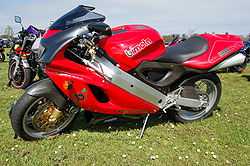Bimota
 | |
| Type | Private |
|---|---|
| Industry | Motorcycle |
| Founded | 1973 |
| Founder(s) |
Valerio Bianchi Giuseppe Morri Massimo Tamburini |
| Headquarters | Rimini, Italy |
| Website | www.bimota.it |
Bimota is a small, Italian manufacturer of custom and production motorcycles. It was founded in 1973 in Rimini, Italy by Bianchi, Morri and Tamburini. The company name is a portmanteau derived from the first two letters of each of the three founders' surnames, i.e. Bianchi Morri Tamburini.
Products
Because the state of frame design and overall packaging was poor,[1] Bimota concentrated initially on building high-quality motorcycles around existing engines. From the beginning they customised the top models of Suzuki, Honda and Kawasaki. During the late 1970s, Bimota also helped develop and build motorcycles branded as Lamborghinis. In the 1980s they also customised Yamaha and Ducati motorcycles.
Bimota's co-founder and long-time chief designer Tamburini has been an influential player in the development of other Italian brands, most significantly his work on the popular Ducati 916, the Ducati Paso, and the MV Agusta F4; other designers such as current Bimota chief Sergio Robbiano have also been involved with larger-volume manufacturers.

Bimota models currently in production include the DB5, DB6, DB7 and the Tesi, with a DB8 featuring the Ducati 1198 engine in development. The latest model features the Tesi 3D which along with the co-designed Vyrus is said to be the only bike on production to house Hub Steering.
Racing

Bimota first experienced international racing success in 1980 when Jon Ekerold, a true privateer, won the 350cc world championship on a Yamaha-powered Bimota.[2] They also experienced success in the early years of the Superbike World Championship. Virginio Ferrari won the 1987 Formula TT title aboard a YB4 EI, partnering with Davide Tardozzi. Tardozzi won five races in the inaugural 1988 world superbike championship, more than any other competitor, but inconsistent results relegated him to third place in the final standings.[3] After many years without success, the Australian rider Anthony Gobert caused a major shock in 2000 by winning a wet race at Philip Island on a Bimota SB8R.
Bankruptcy and rebirth
The V Due, introduced in 1997, had a design flaw with their engines. Bimota was forced to ditch the novel fuel injection system and re-engineer the entire engine. Bimota ultimately recalled the entire run of the motorcycle. While this was occurring, during the 2000 World Superbike season, one of Bimota's main sponsors disappeared, owing the company a great deal of money. The combination of events forced Bimota to file for bankruptcy and close their doors.
In 2003, a new group of investors purchased the rights to the Bimota name and designs and restarted the company.

See also
- List of Italian companies
- List of Bimota motorcycles
References
- ↑ "The Ultimate History of Fast Motorcycles", By: Brown, Ronald. Pages 148-149, 174-175, 210-211, 230, 248-249, 286-287 Published by Parragon Publishing 2002. ISBN 1-4054-5466-0.
- ↑ Noyes, Dennis; Scott, Michael (1999), Motocourse: 50 Years Of Moto Grand Prix, Hazleton Publishing Ltd, ISBN 1-874557-83-7
- ↑ "1988 World Superbike Championship final standings". worldsbk.com. Retrieved 13 January 2013.
- "The Ultimate History of Fast Motorcycles", By: Brown, Ronald. Pages 148-149, 174-175, 210-211, 230, 248-249, 286-287 Published by Parragon Publishing 2002. ISBN 1-4054-5466-0.
- Bimota.it Historical Models. Accessed October 5, 2012. http://www.bimota.it/en/storia_modelli.asp
- Bimota.it Company History. Accessed October 5, 2012. http://www.bimota.it/en/storia.asp
External links
| Wikimedia Commons has media related to Bimota. |
| ||||||||||||||||||||||
| ||||||||